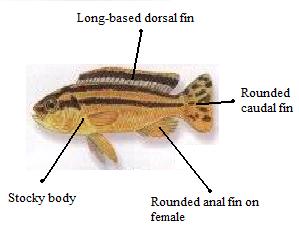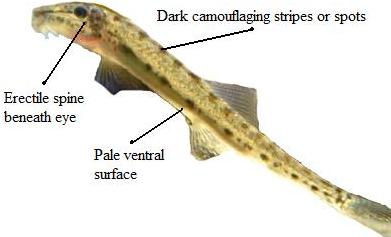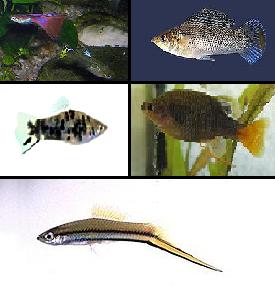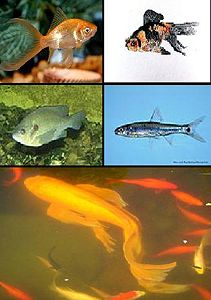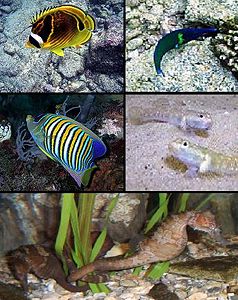Fish/How fish are grouped
All fish are defined by their scientific species name, which is recognized worldwide. Similar species are grouped into "genera," which in turn are grouped into families, as shown below. Characteristics of some of the main groups are set out below the Taxonomy section.
Taxonomy
Freshwater Fishes
Cyprinids
The cyprinid family contains around 1,300 species, widely distributed on most continents of the world. They inhabit all types of waters and adapt readily to various water conditions.
The body shape is conventional, with symmetrical contours, but it may be slender or quite deep, depending on habitat. Cyprinids have seven fins: two sets of paired fins and three single ones. Pharyngeal teeth in the throat grind food before it reaches the intestine. The arrangement of these teeth provides positive identification between similar species.
Coldwater cyprinids include the most popular aquarium fishes of all, the Goldfishes and Koi. Tropical cyprinids are divided into three main groups: barbs, which are like miniature carp, inhabit the middle and lower water levels; danios are faster swimming and prefer the upper levels; and rasboras use all water levels. All cyprinids spawn using egg scattering methods and do not usually exercise parental care.
Characins
The characin family includes around 1,300 species, distributed across Central and South America, and Africa. Most of these fishes school in lakes and rivers.
Body shapes and sizes vary considerably, from 2 in (5 cm) long pencilfishes to the stocky African distichodus species, which measure 16 in (41 cm). Piranhas and pacus are muscular and heavily built to facilitate the tearing of flesh or fruits. Other characins , in contrast, may persistently eat aquarium plants. Characins have sharp teeth in the jaws and mos have an extra fin, known as the adipose fin, on the back. The family contains many popular fishes, including the tetras, of which the brilliant Neon and Cardinal Tetras are prime examples.
Most characins spawn using egg-scattering methods. The male may have tiny hooks on the anal fin to hold the female against him during spawning. The eggs are adhesive and usually lodge among plants. One exception is the Splashing Tetra, which deposits eggs on a firm surface out of the water, to protect them from the attentions of aquatic predators.

Diversity of the skull in the Cichlidae. (a) Rhamphochromis macrophthalmus, a piscivore, (b) Haplochromis euchilus, a digger in sand, (c) Labidochromis vellicans, a picker of small arthropods, (d) Lethrinops brevis, a digger in sand, (e) Petrotilapia tridentiger, a rock scraper, (f) Labeotropheus fuelleborni, an algal-eating rock scraper, (g) Haplochromis similis, a leaf chopper, (h) Genyochromis mento, a scale eater.
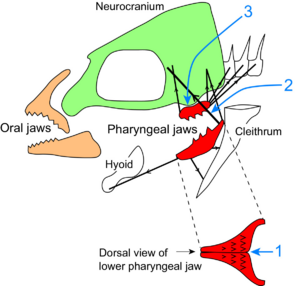
Diagrammatic representation of the principal components of the specifically modified pharyngeal jaw apparatus of cichlids. Red elements are the upper and lower pharyngeal jaws. The muscles organizing the pharyngeal jaw apparatus are represented as black thick lines, and the principal directions of force have been indicated by arrows. Numbers indicate three major features of the specialized "labroid" pharyngeal jaw apparatus: 1) the left and right lower jaw elements are fused into a single structure, 2) the lower jaw is suspended in a muscular sling that runs from the neurocranium to the posterior muscular arms of the lower jaw, and 3) the upper jaw elements have a diarthrotic articulation with the underside of the neurocranium.
The 1,000 or more members of the cichlid family are native to Central and South America, Africa, Asia, and parts of the USA. Most will acclimatize well to domestic tap water, although some species, such as the discus fish, need carefully controlled water.
The colors, shapes, and sizes of cichlids vary enormously, although they tend to be heavily built. Some grow to large for the average community tank, while others breed readily among other fishes in any aquarium. Male cichlids from the Americas may have longer, more pointed dorsal and anal fins, while male African Rift Valley cichlids often have yellow or orange spots on the anal fin. There is plenty of opportunity for specialization within this family: Rift Valley cichlids, for example, prefer hard water and rocky furnishings. Many are herbivorous, requiring vegetable foods. Cichlids are hearty eaters and produce a lot of waste, which calls for frequent water changes. Generally these fishes reproduce by egg-depositing, but they display diverse methods of breeding, all of which involve a high degree of parental care.
Anabantids
Fishes within this group of families often inhabit oxygen depleted waters of Africa and Asia. They possess an auxiliary breathing organ that enables them to use atmospheric air gulped at the surface. This "labyrinth organ" is a folded mass of bone and capillary-rich tissue, situated internally near the gills. Its function is to store air and extract oxygen.
The Asiatic anabantids are usually peaceful and swim gracefully. Gouramies have threadlike pelvic fins with taste cells at the tips. A few other Asian species make croaking noises when they are breeding or when removed from the water. African species are larger and are stealthy predators, often with spectacular colors and patterns.
Most anabantids build floating bubble nests in which the eggs are deposited. The male spurns the female once spawning is completed. He may even kill her as he takes on responsibility for guarding the eggs in the nest. An exception is the mouth-brooding Chocolate Gourami.
Killifishes
Killi is a Dutch word meaning "stream" or brook, but the 300 killifish members of the family Cyprinodontidae in fact inhabit a great variety of waters. These include ephemeral ponds, brackish marshes, lakes, and rivers of the Americas, Africa, Asia, and warmer parts of Europe. Their small cylindrical bodies have upturned mouths for surface feeding. Males are usually more brilliantly colored. In captivity, killifishes accept most types of food. They lay eggs in plants or in the substrate. In both cases, eggs may take weeks or months to hatch and they can survive periods of almost total dehydration. Many subspecies of various coloration have led to confusion with identification.
Catfishes
The catfish family contains around 2,000 members, which include some of the more unusual aquarium attractions: certain species swim upside down; some can maneuver on land; and others can emit sound or use electricity to kill. All are from the Americas, Africa, and Asia and share the common characteristic of bottom-dwelling. Many are surprisingly gregarious and enjoy being kept in numbers, but some catfish are nocturnal, and their regular activities often go unnoticed. Catfishes are identifiable by the barbels around their mouths, which allow them to locate food in the dark. Instead of scales, the skin may be naked or covered with bony plates, or scutes. They often use oxygen that is gulped at the surface and extracted in the gut. Usually omnivorous, some species are herbivorous and are useful in controlling algae. Catfishes spawn in several ways, including egg-depositing and bubble nest building.
Loaches
Loaches are fish families in the order of the Cypriniformes. The various species of loach that are available to the aquarist come from India and Asia. They spend most of their time on the bottom of rivers and streambeds, hence their flat-bottomed bodies. A distinctive characteristic of this family is the erectile spine beneath the eye. It acts as a deterrent to predators, but it also tends to catch in the fish-keeper's net. The mouths of loaches are downturned and have barbels for detecting food.
Like anabantids and some catfishes, loaches can gulp atmospheric air at the water's surface and extract oxygen from it as it passes through the gut. Many species are nocturnal and hide among plants and rocks by day, emerging as darkness falls or when food appears at close range. Their natural diet includes worms and insects, but most loaches will accept prepared foods in captivity, especially tablets and other quick sinking forms.
Little is known of their reproductive behavior, but loaches have been induced to spawn in captivity by using hormone injections. Loaches in the Botia genus are long-established aquarium favorites.
Other tropical egg-laying species
Many egg-laying fishes are monotypic - occurring as a single species within their genus. Some genera contain very few species and other species do not fit conveniently into the major fish groups.
There is an extraordinary variety of fishes to choose for the aquarium within this category, from both brackish and fresh waters. Their physical characteristics are too varied to describe in general terms. These species are sometimes kept by hobbyists as interim choices before graduating to the more demanding field of marine fish-keeping.
They have been chosen to demonstrate the range of fishes available to enliven even the smallest aquarium. Commercial availability of some of these species may be limited.
Tropical livebearers
Livebearing fishes are native to the Americas, from New Jersey down to Brazil, and in east Asia. They have been introduced into other tropical areas to combat malaria, as livebearers eat the waterborne larvae of disease-carrying mosquitoes.
Females are usually longer than males, but the latter have more striking colors and patterns, and often have longer fins. Most livebearers adapt well to the aquarium and will thrive in hard water. Feeding is uncomplicated, but these fishes appreciate the addition of vegetable matter.
A main attraction of these fishes is their propensity to breed in captivity, especially the brilliantly colored, aquarium-developed strains of guppies, mollies, platys, and swordtails. It is advisable to move a gravid female into a separate nursery tank for birthing. This should be heavily planted to shield the young from their hungry mother.
Coldwater freshwater fishes
The popularity of ornamental coldwater fishes sustained the aquarium hobby for hundreds of years until the tropical varieties were introduced in the 19th century. Coldwater aquarium species are mostly cultivated varieties of the Common Goldfish (Carassius auratus), a member of the cyprinid family originating in Asia. A near relative in the same family, the Koi (Cyprinus carpio) has been developed in Japan, although it is generally kept in the outdoor pond rather than the aquarium. Koi are traditionally viewed and judged from above and their colors are developed accordingly. Goldfishes and Koi are long-lived and adapt well to aquarium and pond culture. No standard size descriptions can be made, as they generally grow to the limits of their environment, and no habitat can be given as they are aquarium developed.
A number of species from temperate regions of North America, Europe, and Japan have recently become popular as aquarium fish. There may be local laws against selling some species or removing them from their habitat.
Marine Fishes
Tropical marine fishes
Marine fishes are the most beautiful candidates for the aquarium, but they are also the most intolerant of changes in water quality. Keeping them is a specialization that should be approached gradually and informatively. Beginning with the more hardy species is less expensive, and is educational.
Tropical marine fishes generally come from coral reefs and coastal areas throughout the tropical oceans of the world. The choice of shapes, sizes, and colors is extensive, and the question of compatibility must be considered during selection. Many marine fishes are territorial, and the may be intolerant of other members of the same species. Hiding places should always be provided. Some species form natural relationships with other fishes or invertebrates, and these may be kept together: anemone-fishes, for example, appreciate the addition of sea anemones.
The breeding of these fishes is often restricted to anemonefishes and gobies.
Coldwater marine fishes
Fish-keepers who live near the seashore may be able to collect species from pools that are isolated by receding tides. If these species outgrow the aquarium, they can easily be returned to the shore. The selection of species described in this section does not represent all temperate coastal regions but is offered as an indication of the variety of species that can be collected by the fish-keeper. Generally speaking, it is likely that coldwater fishes will be rather subdues in color compared with their tropical relatives. A mottled brown coloration is generally the norm.
Most coldwater marine fishes depend on rocky retreats, so these should be provided in the aquarium. A fine, deep substrate will enable burrowing fishes, like the wrasse, to feel secure. As with tropical aquariums, you can add invertebrates for interest: sea anemones, shrimps, starfish, and small crabs can be included to enliven a coldwater marine scene. Native marine fishes can be kept fairly cheaply in a medium to large tank. Coldwater marine aquariums must be checked for overheating during the summer.



